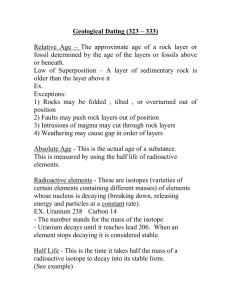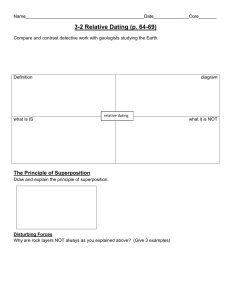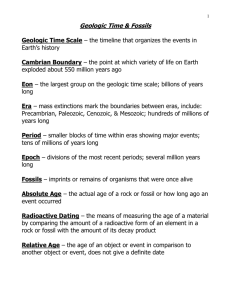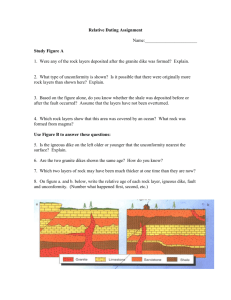Chapter 28: Geologic Time How old is the earth?
advertisement
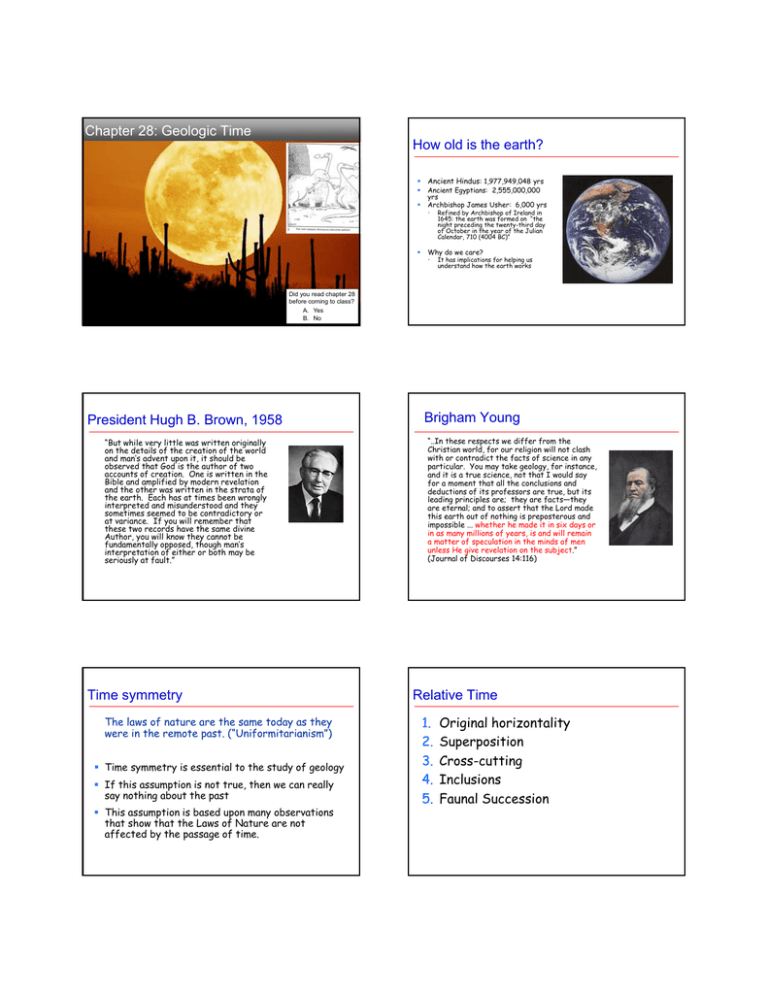
Chapter 28: Geologic Time How old is the earth? Ancient Hindus: 1,977,949,048 yrs Ancient Egyptians: 2,555,000,000 yrs Archbishop James Usher: 6,000 yrs • Refined by Archbishop of Ireland in 1645: the earth was formed on “the night preceding the twenty-third day of October in the year of the Julian Calendar, 710 (4004 BC)” Why do we care? • It has implications for helping us understand how the earth works Did you read chapter 28 before coming to class? A. Yes B. No President Hugh B. Brown, 1958 “But while very little was written originally on the details of the creation of the world and man’s advent upon it, it should be observed that God is the author of two accounts of creation. One is written in the Bible and amplified by modern revelation and the other was written in the strata of the earth. Each has at times been wrongly interpreted and misunderstood and they sometimes seemed to be contradictory or at variance. If you will remember that these two records have the same divine Author, you will know they cannot be fundamentally opposed, though man’s interpretation of either or both may be seriously at fault.” Time symmetry The laws of nature are the same today as they were in the remote past. (“Uniformitarianism”) Time symmetry is essential to the study of geology If this assumption is not true, then we can really say nothing about the past This assumption is based upon many observations that show that the Laws of Nature are not affected by the passage of time. Brigham Young “..In these respects we differ from the Christian world, for our religion will not clash with or contradict the facts of science in any particular. You may take geology, for instance, and it is a true science, not that I would say for a moment that all the conclusions and deductions of its professors are true, but its leading principles are; they are facts—they are eternal; and to assert that the Lord made this earth out of nothing is preposterous and impossible ... whether he made it in six days or in as many millions of years, is and will remain a matter of speculation in the minds of men unless He give revelation on the subject.” (Journal of Discourses 14:116) Relative Time 1. 2. 3. 4. 5. Original horizontality Superposition Cross-cutting Inclusions Faunal Succession Original Horizontality Superposition Sedimentary rock layers are built up one upon another so that the youngest layers are on the top of the pile and the oldest layers are on the bottom. Sedimentary rocks were originally deposited in layers that were near horizontal. If they are now tilted, then some event must have occurred after deposition to change their orientation. Horizontal Tilted Cross-cutting Relationships Cross-cutting Relationships: Faults Where one rock body or event (like a fault) cuts across another rock body, we conclude that the youngest rock or event is the one cutting across. The older rock must have been there first so that the younger one could cut through. Fault in glacial sediment Hydrocarbon dike cutting sandstone Granite dikes cutting darker rock Salt Lake Temple granite Inclusions If one rock is included within another rock, then the included rock must be older than the rock it is found within. Dark inclusions in granite, Yosemite National Park. (Lens cap & student for scale) Wasatch Fault near Sandy Conglomerate Faunal Succession In sedimentary rock layers we find a predictable succession of fossil animal and plant remains. This pattern can be used to determine the relative ages of rock layers. Geologic Column Based upon the fossil record, geologists have given names to the different ages of rocks. This is called the “Geologic Column.” Trilobites Mammoth Tusks Ammonites Trilobites Bacteria Unconformities Unfortunately, the geologic record is not usually complete. Scattered throughout the record, in any given locality, are gaps or places where the record is missing due to erosion or nondeposition. These gaps in the record are called “Unconformities.” Angular Unconformity ~350M years old Putting Together a Geologic History Using the principles of “Relative Dating” we have just discussed, let’s see if we can determine the sequence of events that formed the Grand Canyon History of the grand canyon Higher up we find a layers of horizontal sediments above tilted layers of sediments At the very bottom there are tilted and deformed layers with other types of rocks intruding. Horizontal sediments Horizontal sediments Tilted sediments Tilted sediments What is the Sequence of Events? E, G, L, C deposited fault H erosion, unconformity M, D, J deposited A intruded erosion, unconformity N, K, B deposited tilting, erosion, unconformity F deposited erosion of current surface Which feature is the oldest? Getting an absolute (numeric) age. Radioactive dating Need long-lived radioactive isotopes to date Earth events. A C D B Half life ~1.2B years The relative percentage of parent to daughter isotope allows us to tell age What are we dating with these radioactive isotopes? The age of the elements? • NO! We are determining the age of events • Usually the last time the rock or mineral was heated above its “Closure Temperature” • Below the closure temperature the system is closed and the isotopes can accumulate • Above the closure temperature the system is open and the isotopes may escape, resetting the clock • Each mineral and isotope system has a different closure temperature Requirements for accurate radioactive dating Closure Temperatures for some isotopic dating systems System Mineral Closure T - ºC K-Ar Hornblende 500 K-Ar Biotite 300 Fission Track Zircon 225 Fission Track Apatite 100 Then. . . the ratio of the original isotope to the product gives the absolute date the rock formed. Other Ways to measure time Little Cottonwood Salt Lake Temple granite 1. 2. 3. 4. 5. Top “old” When was this granite formed? Do all mineral systems give the same age for this granite? If not what events are they recording? 1. A known half life 2. A sample of rock (igneous) representative of the geologic layer to be dated. 3. No end products present when the rock cooled (or corrections must be made) 4. No loss or gain of either the isotope or the product since the rock cooled. Base “young” System Mineral Closure T Age Top Age Base K-Ar Hornblende 500 ºC 30 my 30 my K-Ar Biotite 300 ºC 28 my 28 my Fission Track Zircon 225 ºC 20 my 10 my Fission Track Apatite 100 ºC 11 my 6 my Tree Rings Annual Sediment Layers in Glacial Lakes Annual Layers of Snow and Ice in Glaciers Accumulation of Cosmic Ray Damage Sedimentation (Estimates ranging from 3 to 1500 M yrs made in Early 1900s) Other Ways to measure time 6. Cooling of the earth (Lord Kelvin estimated an age of ~100M yrs in 1860) How old is the earth? It is not infinite in age. because radioactive elements with long half-lives still exist in the crust. It is older than a few million years because radioactive elements of such “short” lifetimes have all disappeared. It is older than the oldest dated earth rock--older than 3.8 billion years. It is similar in age to the moon. Some moon rocks cooled below closure temperature about 4.5 billion years ago. Best estimate: ~ 4.6 billion years What if… The history of the Earth was recorded in a time lapse movie? Every year takes up only one second of the movie Then.. • The movie would take 146 years to watch Other Ways to measure time 7. Salinization of the oceans (Joly estimated an age of 90M yrs in 1899) What if… the history of the Earth was written down and each year was allotted a paragraph one inch long on an 8½ x 11 inch page. How thick would the book be? • • • With half-inch margins (10 inches of text per page) Print on both sides of the paper Use paper like you have in your PS100 text Then.. • The book would be • • 5,000 years per inch of stacked pages The whole book would be about 14½ miles thick Geologic time scale compressed to one calendar year Recorded human First fossils history starts less than a minute before midnight (algae) Earth forms Jan Jul Feb Mar Aug Sep Fossils of multi-celled organisms Apr Oct May Jun Nov Dec Fossils of insects Fossils of animals with hard skeletal parts & land plants Humans dinosaurs, mammals Grasses
